SHAF1ZR
1732
SHAKERS
a source approximates a point, the more nearly does the penumbra vanish. This almost complete absence of penumbra is well-shown in the shadows cast by naked electric arcs. In case a shadow is produced
FIG. 2
by a point-source it is always accompanied by a series of diffraction-fringes, called, after their discoverer, Grimaldi's fringes. These are beautifully shown in the case of the naked arc-light, where the first three fringes of the series are easily seen bordering the shadow of each twig on a tree or the shadow of one's lead-pencil cast on a sheet of white paper. For explanation of these fringes see Preston's Theory of Light.
Shatter, William Rufus, American general, was born at Galesburg, Mich., Oct. 16 1835. In 1861 he entered the Union army as lieutenant in the ythi regiment of Michigan volunteers, and distinguished himself in the campaigns under McClellan in Virginia. He rose to be lieutenant-colonel and subsequently was brevetted brigadier-general for gallantry in action. When the volunteer army was disbanded at the close of the Civil War, he entered the regular army as lieutenant-colonel of the 4ist United States infantry. After this he rose to be colonel, and then brigadier-general in 1897 On the outbreak of the war with Spain (q. v.) he was put in command of an expedition to Cuba (q. v.) with the rank of major-general of volunteers. In May 1898, he proceeded to Tarnpa, Fla., then to Cuba, where, in June and July, he commanded the military operations which ended in the capitulation of Santiago (q. v.) de Cuba and the surrender of General Linares* army of over 20,000 men. He subsequently was in command of the department of California and the Columbia, and was retired on June 30, 1901. He died on Nov. 12, 1906. See SPANISH-AMERICAN WAR.
Shag. See COR'MORANT.
Shagreen', a name given to the skins of sharks, rays and other fish of the same family. These skins have a covering of small, hard grains, which stand wear better than ordinary leather. Such skins, when prepared like parchment and dyed and smoothed, have an attractive look, and are used for covering small caskets, cigar-cases, spectacle-cases and small boxes. The name "shagreen," a Persian word meaning the back of a beast of burden, is also, and perhaps was first/given to skins of horses, asses and other animals, prepared by un-hairing and scraping them. Each piece is then stretched on a frame; and, while still
moist, the seeds of a kind of chenopodium are sprinkled on the surface and forced in by the feet or a press. When the skin is dry, the seeds are beaten out, leaving a pitted appearance. It is then pared down and placed in water, till the pits swell and give the skin a pimpled look, like that of the shark. The covers of old Persian manuscripts are made of this shagreen, which is also used in the east for horse-trappings and shoes. Wood is embossed sometimes in a like way.
Shah, the title applied by Europeans to the ruler of Persia. It is a general name for king, widely used in southern a'nd central Asia. The full Persian form is Padishah.
Shah-Jehan', the fifth of the Mogul emperors of Delhi. For the last four years of the reign of his father, Emperor Jahangir, he was in open rebellion. Greeted as emperor by the nobles on Jahangir's death in 1627, he began a warlike and successful reign, conquering the Deccan kings of Ahmadnagur, Bijapur and Golconda. He was an able and just ruler, and a good business-manager as well. The magnificence of his court was unequaled, The splendid peacock-throne was built by his orders at a cost of nearly $35,000.000. Of other great public buildings which remain as a monument of his greatness are the grand Taj-Mahal (q. v.) and the matchless pearl-mosque at Agra and the palace and great mosque at Delhi. He was deposed in 1658 by Aurungzeb, his son, and died in 1666.
Shah'jahan'pur, a city of British India, in the northwestern provinces, is 100 miles northwest of Lucknow. It takes its name from Shah-Jehan, in whose reign it was founded in 1647. It was a hotbed of rebellion during the mutiny of 1857-8. Sugar is made and exported here. Population 76,458.
Shak'ers, a religious sect. They arose in England about the middle of the iSth century, under the leadership of James Ward-law and his wife. They were Quakers, but professed to have had a revelation that the second coming of Christ was at hand and that he would appear in the form of a woman. Ann Lee was one of their first converts, and her preaching drew such crowds that she and the Wardlaws were imprisoned. While in prison she professed to have received another revelation, which made her accepted as the female Christ whose reign had been promised. She was called Mother Lee, and is considered the head of the Shakers. The new kingdom, by revelation they learned, was to be set up in America, and the first settlement was made in Albany County, New York, five miles from Albany. Their special doctrines are holding property in common; celibacy or refraining from marriage; and the duty of labor. They live in families of brothers and sisters, presided over by elders and elderesses
